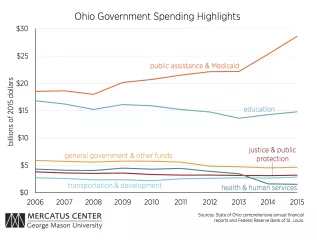- | Academic & Student Programs Academic & Student Programs
- | Housing Housing
- | Research Papers Research Papers
- |
How the Gem City Lost Its Luster and How It Can Get It Back
A Case Study of Dayton, Ohio
Urban decline is a complicated process and has no single cause, but studying the details of one city’s decline can still help explain the experiences of other cities in the same region. For instance, Dayton, Ohio, is in many ways an archetype of the declining Rust Belt city.
Adam A. Millsap, an affiliated scholar for the Mercatus Center at George Mason University, explores Dayton’s history to explain why it and other Rust Belt cities must avoid letting regulations and taxes stifle entrepreneurship. Since cities like Dayton cannot compete with other cities on the basis of climate and geography, they need to create a business environment that fosters specialization and innovation to generate economic growth.
Dayton's History
Dayton experienced a dramatic rise in the early 20th century, but de facto racial segregation, a poorly educated labor force, and failed revitalization projects precipitated its decline through the turn of the 21st century.
- From its founding in 1880 until 1930, Dayton experienced substantial population growth and was the innovation center of the region, priding itself on not being a one-industry city. In 1913 Dayton adopted a “city manager” model of government that allowed it to reform its corrupt civil service system and reap large benefits from improved local services.
- From 1930 to 1960, Dayton became relatively less important in the region. Southern migration patterns influenced by Federal Housing Authority policy resulted in a highly segregated city. By 1960, residents had begun to express their discontent by leaving Dayton in large numbers.
- From 1960 to 2010, interstate highway construction lowered the cost of living outside Dayton. Meanwhile, migration of primarily low-skilled workers from the South contributed to a decline in the average skill level of the city’s workforce, especially as higher-skilled workers left the city. The simultaneous population loss and loss of high-skilled workers inhibited Dayton’s ability to reinvent itself. The city’s economy became heavily reliant on older industries, particularly the auto industry. In response, Dayton invested in large revitalization projects, such as a downtown stadium, to attract new residents and firms—but these have been largely unsuccessful.
- Since 2010, Dayton has experienced relative stability. The city’s economy has shifted from manufacturing to services, but lower full-time employment and declining earnings, home values, and population exemplify the fiscal and economic difficulties the city still faces.
The Path to Renewal
Climate, industry composition, taxes, and the costs of doing business help determine the success of cities, but Dayton policymakers can only influence the latter two. In order to lay the groundwork for revitalization, Dayton officials must optimize the policies under their control.
- Dayton’s residents face high taxes compared to residents of surrounding communities. The city should review its financial obligations to find tasks that can be accomplished more efficiently in order to lower income and property tax rates without undermining basic services.
- To improve its business climate, Dayton should implement a policy of permissionless innovation—that is, it should permit experimentation with new models of land use, new businesses, and new technologies by default rather than managing them through policies like business and occupational licensing requirements and zoning restrictions.
Conclusion
Ohio law gives city officials in Dayton more control over the city’s business environment than local policymakers have in many other states. Dayton needs to take advantage of this power to attract the entrepreneurs and high-skilled individuals that will allow it to once again fulfill the economic role of a city: a place of specialization and innovation.
To speak with a scholar or learn more on this topic, visit our contact page.


